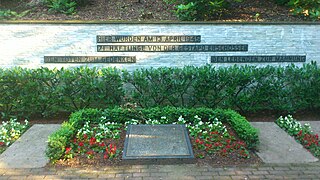Massacre in the Wenceslas Gorge
When massacre in the Wenzelberg gorge on 13 April 1945 to Langenfeld city ( Mettmann , North Rhine-Westphalia ) in a canyon of Wenzel Berg in the course of war final phase crimes 71 inmates from the penitentiary Luettringhausen of Gestapo executed ists. After the war, the bodies were exhumed by locally known National Socialists under the supervision of American occupation soldiers and later buried in front of the town hall in Solingen-Ohligs . In 1965 the victims were reburied at the Wenzelnberg memorial , where an annual commemoration event takes place.
chronology
On April 13, 1945, 68 men known by name and three unknown men died in a ravine of the Wenzelnberg , who were executed there by the National Socialists without trial . For the chronicle of the crime, the information on the plaque at the Wenzelnberg memorial :
- January 24, 1945
- The Reich Main Security Office sent a telegram to the heads of the state police in Düsseldorf , Münster , Dortmund and Cologne, demanding that “foreign workers and former German communists” who might be motivated to engage in subversive activities be “immediately exterminated”.
- April 7, 1945
- Field Marshal Walter Model , the supreme commander of Army Group B issued the order of the day , breeding prisoners , within trapped by the enemy prisons incarcerated to pass the security police to the security police inspection. The same applies to the prisons imprisoned border remand when for political offenses or crimes in prison or if penitentiary or the death penalty be expected. Further regulations are assigned to higher SS and police leaders. (Müller adds that Model's headquarters were alternately in Solingen- Aufderhöhe , Hackhausen Castle and Wiescheid , Oststrasse 1 in the Furtmann house.)
- 8th-9th April 1945
- The "Higher SS and Police Leader West", the SS-Obergruppenführer Karl Gutenberger in Essen thereupon gave the commander of the security police Henschke the corresponding daily order, which he passed on to the head of the Gestapo branch in Wuppertal, Hufenstuhl .
- April 10, 1945
- After making an appointment by telephone, Criminal Assistant Dahlmann and three other Gestapo officers appeared at Government Councilor Dr. Engelhardt , head of Remscheid-Lüttringhausen prison . Dahlmann demanded to be allowed to carry out the security police check of the incarcerated prisoners. The head of the institution Dr. Engelhardt managed to reduce the originally requested 600 prisoners to 90. He also succeeded in excluding foreign prisoners.
- At the same time pointed Hufenstuhl the officials Burmann and bird on a pit by foreign forced laborers to have to dig. After initially planning a place in the Ohligser Heide for this purpose, which then didn't seem safe enough, the decision was made to go to the Wenzelnberg gorge. The workers were informed that the pit, the dimensions of which had been precisely determined, was needed as an anti-tank ditch.
- April 12, 1945
- With two closed trucks , a strong police presence appeared on the premises of the detention center around 4 p.m. To the surprise of the Gestapo, it turned out that only 55 of the 90 originally intended prisoners were ready for removal. Dr. Engelhardt was able to place 35 prisoners in work details and thus protect them from being accessed by the Gestapo. Dahlmann then declares that he is ready to take on only six other prisoners, who are to be transferred to him the next morning to the police headquarters in Wuppertal . However, one more prisoner managed to escape , so that only five other prisoners could be assigned to the transport.
- April 13, 1945
- In the morning the prisoners were carted to Wenceslas Hill. Eleven other prisoners from other prisons were served to prisoners from Lüttringhausen, four prisoners each from Wuppertal-Bendahl and Ronsdorf and three men of unknown names and origins. (According to Müller, there were four prisoners on remand from Wuppertal-Bendahl and seven forced laborers incarcerated in Ronsdorf). According to official information, the men were tied by the thumbs in pairs and killed by a shot in the neck . (Incidentally, locals also speak of men who were not shot and who fell tied up in the pit and were buried alive.)
- 14.-17. April 1945
- On April 14th, anti-fascists occupied the town hall in Solingen-Wald. After the advent of the 94th US - Infantry - Division , which was stationed in Langenfeld, the anti-fascists were entrusted with police duties. On April 17, a man who was used for the cordon measures at the murder site reported the mass murder to the American combat commander. Then the still fresh mass grave was discovered at the specified location .
- April 27, 1945
- Members of the Solingen antifa group began investigating the crime together with an American sergeant . At the same time, the exhumation of the dead began.
- April 30, 1945
- May 1, 1945
- Burial of the victims in front of the town hall in Solingen- Ohligs . When asked to attend the memorial service , 3,000 people attended.
- January 19, 1955
- Renewed exhumation of the dead.
- January 23, 1965
- The 71 dead were reburied in 12 coffins on Wenzelnberg as part of a memorial ceremony. Since then, the place of deed has also been a memorial site .
Wenzelnberg Memorial
On Memorial Wenzelberg commemorations found since 1965 held annually, alternately from the cities of Langenfeld , Leichlingen Leverkusen , Remscheid , Solingen and Wuppertal are aligned. The German Federation of Trade Unions also takes part .
Web links
Individual evidence
- ↑ Memorial event in the Wenzelnberg Gorge on aars.blogsport.de
- ^ A b c Rolf Müller, " Stadtgeschichte Langenfeld Rheinland ", Verlag Stadtarchiv Langenfeld 1992


